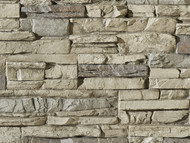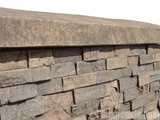
Our panels perfectly mimic the look and texture of authentic stone - and have names which describe the different construction styles they are molded from. But what do these different descriptions mean? Here's a quick guide.
Fieldstone, Ledgestone, Drystack - What do they all mean?
The secret to why our panels look so vividly realistic is that they're molded directly from the real thing; using an innovative process that perfectly captures every nook, cranny and crevice of the stonework to perfectly recreate them in tough and durable polyurethane foam.
The descriptions we use for each of our product lines describes the style of stonework they're molded from - and if you're wondering what those words actually mean, here are some more details:
- Dry Stack Stone Wall: Similar to stacked stone & ledgestone, dry stack walls are built using stone that splinters into naturally symmetrical "bricks" that can be piled on top of each other to make walls. The difference is that dry stacked walls are made without using any type of cement or mortar; which adds a unique look to them. Despite the lack of mortar, dry stack walls can stand for centuries; and in England, Wales and other parts of the world, fences and walls made using this technique are still standing a thousand years after originally being built.
- Fieldstone: Fieldstone walls are made using randomly-sized rocks and stones recovered from fields and farmland - hence the name! Very popular in agricultural areas, many historic homes and walls were built using stones dug up during the ploughing of farmland, prior to the planting of crops, and as a result many people like the look of this walling style because it adds a rural, historical element to their designs.
- Chiseled Stone: A style of construction very popular during the medieval period, chiseled stone/ random rock walls are made using hand-hewn bricks of different sizes; resulting in a unique and asymmetrical appearance given conformity by the style of bricks used, all featuring similar chisel marks and chips that were made when shaping the differently-sized bricks.
- River Rock: River rock walls are similar to fieldstone, in that they're traditionally made from found, rather than manufactured, rocks and stones. With river rock, these are normally stones taken from the banks of rivers and lakes; which are naturally round and smooth thanks to centuries of erosion. This gives river rock walls a unique appearance traditionally associated with rural regions.
- Cobblestone: A uniquely stylish type of construction, cobblestone walls are made using "cob" or found stones and bricks, bonded together with sand or mortar. As a result, cobblestone walls are vividly asymmetrical, and are traditionally associated with medieval or colonial building styles, as cobblestone was largely replaced with the use of cut granite during the 19th century.



